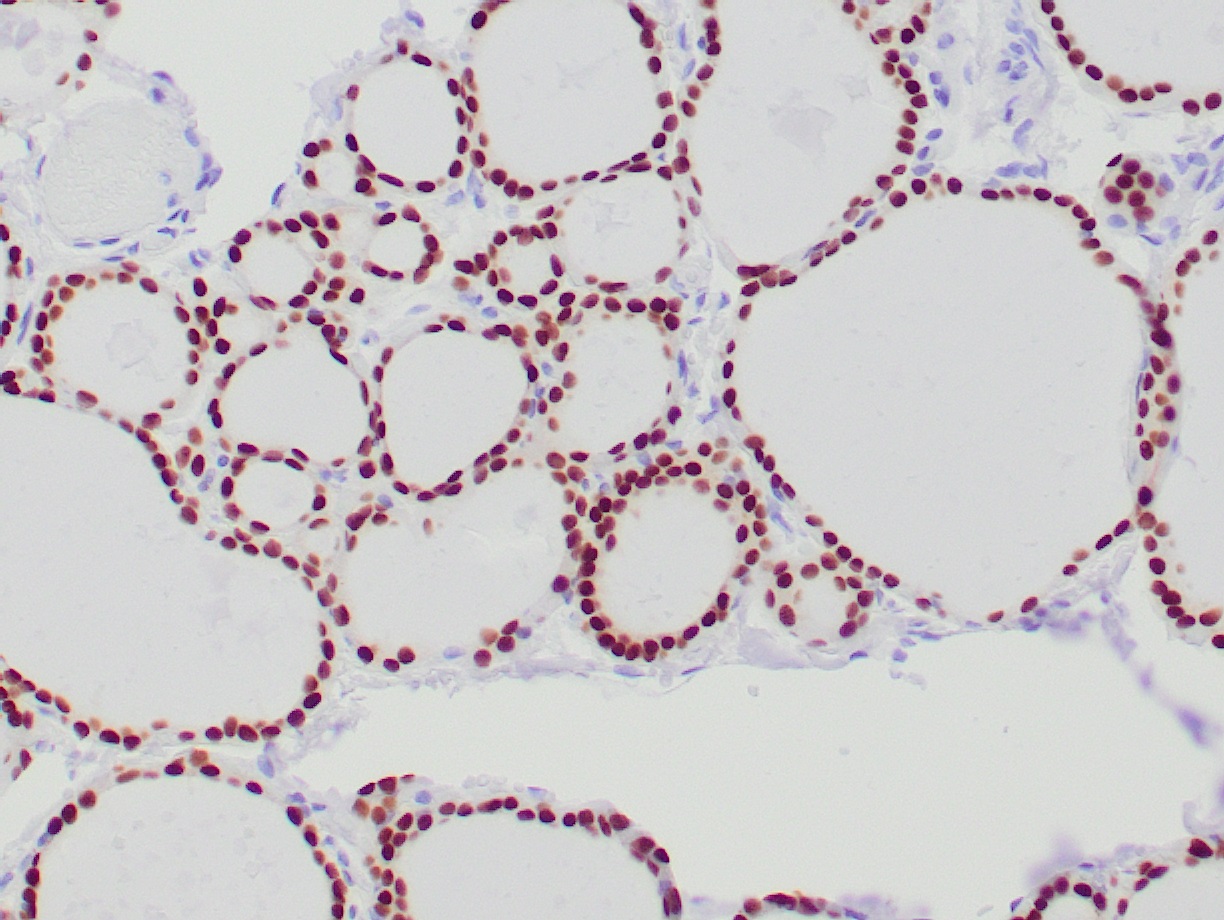Catalogue

PAX-8 (Paired box protein 8)
Catalog number: PAX008-0.5| Clone | ZR1 |
| Isotype | IgG |
| Product Type |
Monoclonal Antibody |
| Units | 0.5 ml |
| Host | Rabbit |
| Species Reactivity |
Human |
| Application |
Immunohistochemistry (frozen) Immunohistochemistry (paraffin) |
Background
PAX-8 is expressed in the thyroid, non-ciliated mucosal cells of the fallopian tubes and simple ovarian inclusion cysts, but not normal ovarian surface epithelial cells. The antibody against PAX-8 is well suited for the detection of the protein in ovarian clear cell carcinoma. The cellular localization is nuclear. PAX-8 is expressed in the thyroid (and associated carcinomas), non-ciliated mucosal cells of the fallopian tubes and simple ovarian inclusion cysts, but not normal ovarian surface epithelial cells. PAX-8 is expressed in a high percentage of ovarian serous, endometroid, and clear cell carcinomas, but only rarely in primary ovarian mucinous adenocarcinomas. Studies have also found PAX-8 expression in renal tubules as well as renal carcinoma, nephroblastoma and seminoma. Over 98% of clear cell RCCs, 90% of papillary RCCs, and 95% of oncocytomas were positive for PAX-8, frequencies which are similar or better than for PAX-2. Normal lung and lung carcinomas do not express PAX-8. Similarly, the absence of expression of PAX-8 in breast and other non-GYN carcinomas other than those primary to the thyroid indicates that PAX-8 is an important new marker of ovarian cancer and a useful marker for the differential diagnoses in lung and neck tumors, or tumors at distant sites where primary lung carcinoma or thyroid carcinoma are possibilities. PAX-8, combined with organ system-specific markers such as uroplakin, mammaglobin, and TTF-1 can be a very useful panel to differentiate the primary site of invasive micro-papillary carcinomas of ovary from those of the bladder, lung, and breast. The ZR1 antibody does not react with pancreatic neuroendocrine tumors, thymic tumors, and lymphocytes.
Synonyms: Paired box protein 8
Source
Rabbits were immunized with a synthetic peptide corresponding to the C-terminus of Human PAX8 protein.
Product
Tissue culture supernatant with 0.2% BSA and 15 mM sodium azide
Specificity
Species Reactivity: Human, others not known
Applications
IHC (C,P)
Staining procedures: Use formalin-fixed and paraffin-embedded sections. Retrieval conditions: Pretreatment of deparaffinized tissue with heat-induced epitope retrieval (EDTA, pH9.0) is recommended. Detection methods: Polymer anti-mouse/rabbit Ig detection system. Working dilution: 1:50-100; Positive Control: Ovarian serous carcinoma. Cellular Localization: Nuclear.
Working Concentration: (liquid conc.) 1:50-1:100
Pre-Treatment: Pre-treatment of dewaxed tissue with heat-induced epitope retrieval (TRIS/EDTA, pH9.0 Ref. DE006) is recommended.
Positive Control: Thyroid carcinoma, Ovarian Clear Cell Carcinoma
Storage
2-8°C
Shipping Conditions: Ship at ambient temperature.
Caution
This product is intended FOR RESEARCH USE ONLY, and FOR TESTS IN VITRO, not for use in diagnostic or therapeutic procedures involving humans or animals. It may contain hazardous ingredients. Please refer to the Safety Data Sheets (SDS) for additional information and proper handling procedures. Dispose product remainders according to local regulations.This datasheet is as accurate as reasonably achievable, but Nordic-MUbio accepts no liability for any inaccuracies or omissions in this information.
References
1. Poleev A., Fickenscher H., Mundlos S., Winterpacht A., Zabel B., Fidler A., Gruss P., Plachov D. PAX8, a human paired box gene: isolation and expression in developing thyroid, kidney and Wilms' tumors. Development 116:611-623(1992) [PubMed: 1337742]
2. Kozmik Z., Kurzbauer R., Doerfler P., Busslinger M. "Alternative splicing of Pax-8 gene transcripts is developmentally regulated and generates isoforms with different transactivation properties. Mol. Cell. Biol. 13:6024-6035(1993) [PubMed: 8413205]
3. Vilain C., Rydlewski C., Duprez L., Heinrichs C., Abramowicz M., Malvaux P., Renneboog B., Parma J., Costagliola S., Vassart G. Autosomal dominant transmission of congenital thyroid hypoplasia due to loss-of-function mutation of PAX8. J. Clin. Endocrin
Protein Reference(s)
Database Name: UniProt
Accession Number: Q06710 (PAX8_HUMAN)
Species Accession: Human
Safety Datasheet(s) for this product:
| NM_Sodium Azide |

|
Immunohistochemical staning of a paraffin section of human thyroid tissue using PAX008-0.5, clone ZR1, detecting nuclear PAX-8. |

Immunohistochemical staning of a paraffin section of human thyroid tissue using PAX008-0.5, clone ZR1, detecting nuclear PAX-8.
